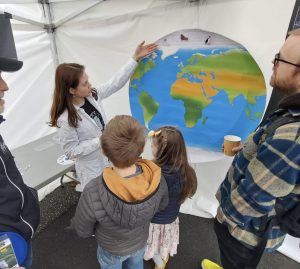Hei Hei! My name is Kirsti and i´m a third year biology student from UiB who is passionate about marine biology. This blogpost is to document and share my experience this past semester. I´ve been participating in the BIO299 course, which give students the opportunity to practice research in Biology.
I kicked off this adventure in January and now I’m wrapping up my report and portfolio now in May. I’ve been super lucky with my advisor and team, the Cnidaria and Ctenophora research group from University Museum of Bergen. My project focuses around using DNA barcoding for the identification of juvenile and damaged hydrozoans, which makes traditional morphological identification quite tricky! This includes, Sampling, Labwork and other activities 🙂
Let’s talk about the sampling trips first 🙂 In December, I joined the team for my very first sea sampling trip ever.
So, picture this: cold Norwegian waters, specialized nets, and a team of enthusiastic researchers. We took samples using a WP3 plankton net to collect samples along with a CTD (conductivity, temperature, and depth) to collect water samples at our sampling stations . Each trip was so fun and interesting as we also had to process samples on board, so we often found some very interesting specimens. These trips were mainly for collecting samples and gave me a fantastic hands-on learning experience in marine fieldwork. It was also super fun to spend time with our team and crew on Hans Brattström along with taking a break from labwork.

(Chromatograms from samples after sequencing)
Back in the lab, the real magic happened. Although i´ve learned about the technicalities of doing a PCR and Gel electrophoresis, I´ve never really done one myself. So unsurprisingly, my very first PCR didn´t work. But lab work is somewhat magical, sometimes things don´t really work but retrying it with the same procedure always ends up working somehow? (hence- MAGIC). In the biodiversity lab at høytek, I spent the majority of my time extracting and running gels of samples I received from my advisor, using 16S and COI markers. The PCR product were then sent to Germany, and after a few days we would receive sequences (Chromatograms). I then made assembled them and BLAST them for identification.
After a few trials and errors of PCRs and gels I started getting more comfortable, and towards the end of my project I was doing 96-plate gels at a time! Labwork was hands down the most interesting part of the experience. I learned various lab techniques, how to troubleshoot, sanger sequencing and contamination prevention, which are key for successful DNA barcoding. And not to mention all the tips and tricks you get by asking either lab technicians and other users for their solutions to things!
Outreach for One Ocean Week
As part of the University Museum of Bergen´s outreach, I got to be involved in One Ocean Week, an event aimed at informing the general public about anything and everything Marine. Our team was sharing a tent with other research groups from the Museum´s research department. It was all about engaging with the public and explaining current findings, our team was focusing on species found in both the Arctic and Antarctic, aka. Bipolar animals!
From school kids to researchers, everyone was eager to talk to us. It was rewarding to see the interest and curiosity in marine science in the general public, especially in younger children 🙂 I also learned a lot as my advisors accompanied me, it never seizes to amaze me how much they know and the research they’ve done!
All-in-All
One of the best parts of this project was getting to know the team and learn from all of them:) From lab work to sampling trips and outreach, each day brought something new and exciting. Lab work has definitely made me more disciplined and structured as it is do easy to lose track of what you’re doing if you don’t note things down (learned this the hard way). Each trip was unique, thanks to the diverse environments we sampled from (Bergen’s unpredictable weather added to the fun!).
This experience has not only fueled my passion for marine biology but also taught me valuable skills to do so. I’m so grateful for the chance to work with such a dedicated team and to contribute to their research, even if it was just a little bit. And a special thanks to advisors Luis Martell and Joan J. Soto-Angel for the warm welcome and amazing experience I was able to have with you. I hope to one day be able to work with you and the team again 🙂
And for those reading and wondering if Bio299 is worth it, I would say yes! It´s such an amazing experience where as a student you get to work independently and systematically. And who knows, maybe you’ll even find something you would like to research later on too.
Thanks for reading, and stay tuned!
Photo: JOAN J. SOTO-ANGEL, LUIS MARTELL, LEA DOBER





